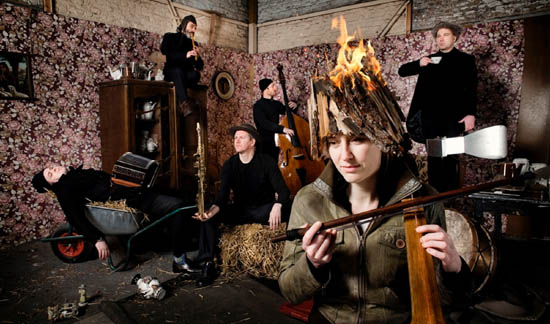|
Zefiro Torna, named for a popular madrigal by Claudio Monteverdi, is no stranger to treating the old as new, and vice versa. In addition to combining a love of medieval and Renaissance music with jazz and other modern modes of expression, the Flemish vocal-instrumental ensemble has worked extensively with performers, stage directors, and individual artists to widen the scope of their repertoire while also hinting at universal impulses within it.
Two recent CDs highlight the adventurous spirit behind such collaborations.
The Allegory of Desire brings centuries-spanning musical settings of the Biblical Song of Songs in conversation with traditional and original Arabic songs interpreted by Tunisian singer Ghalia Benali. Sopranos Cécile Kempenaers and Griet De Geyter are joined by an intimate array of instruments, the Vocalconsort Berlin, and Benali herself.
From the textual (e.g., the two selections from Johann Christoph Bach's "Hochzetiskantate" that frame the program) to the mystical (“Ad latus” from Dietrich Buxtehude's passion cantata "Membra Jesu nostri"), multivalent influences abound. In the latter vein, Hildegard von Bingen's “Favus distillans” is an opportunity for Benali to stretch her vocal nets to haunting effect. It is the only point at which her voice leavens a nominally European brew, for her wings spread widest in her settings of Arabic poems that reinterpret the "Song of Songs." Whether in “Last embrace” or “Dama da'iman” (Last eternity), she is as much the heartbeat as the percussionists, and lends significance to every pause taken between stanzas. And in her rendition of “Lama Bada,” a traditional Andalusian song, she engages the Vocalconsort Berlin in a call and response of exceptional beauty.
In these songs, too, one can hear the adaptability of early music staples such as the viola da gamba and recorders, as well as the lute's origins in the oud. Of the Renaissance selections, highlights include Heinrich Schütz's sacred motet “Ego dormio,” enhanced by strings and lute, and the macramé of madrigals by Monteverdi (whose “Pulchra es” offers a heavenly soprano duet), Orlandus Lassus, Allessandro Grandi, and Giovanni Felice Sances.
On Scattered Rhymes, soprano Juliet Fraser joins core instrumentalists, augmented by the Frank Vaganée Jazz Trio, in a tribute to Francesco Petrarca (a.k.a. Petrarch). Petrarca's love sonnets of the 14th century inspired a range of composers to set them, and Veganée's trio continues this tradition. “Voi ch'ascoltate in rime sparse” (by Sigismondo d'India of the 16th century) sets an evocative tone, both lyrically and musically:
You who hear the sound, in scattered rhymes,
of those sighs on which I fed my heart,
in my first vagrant youthfulness,
when I was partly other than I am…
Fraser sings lucidly and is the beacon toward which the Vaganée Trio rows its improvisational waters. Another singer is also present on the album—not as performer but as composer. Els Van Laethem contributes three songs which especially validate the trio's presence. “Mille piagge” gives drummer Lionel Beuvens, bassist Jos Machtel, and Veganée himself on reeds plenty of room to roam. “Una candida cerva” artfully combines Renaissance charm with slick altoism, and even a drum solo for good measure, while “La gola” is dominated by free improvisation, as is fitting for its obscure verses.
If reading along with the translations, one begins to see an obsessive mind at work (all the sonnets are written about the same woman), and a booklet liner note appropriately describes the sonnets as “Petrarca's own psychoanalytical notebook.” Indeed, as in “Io canterei d'amor” (Cipriano de Rore, 16th c.), the depth of his unrequited love is sometimes borderline perverse. If listening for pure pleasure, however, the songs have much to offer. In the laudatory atmosphere of “Vergine bella” (Guillaume Du Fay, 15th c.), nyckelharpa, lute, and bass shroud Fraser's voice in gossamer before shifting to a jazzy cadenza, while the soprano saxophone of “Non al suo amante” (Jacopo da Bologna, 14th c.) adds spice to Fraser's polyphonic duet with lutenist Jurgen De bruyn (whose delightful original, “Een jonge vrouw,” closes out the disc). Other highlights are a performance of Zefiro Torna's namesake piece and “Vago augelletto,” both masterworks of Monteverdi. Their innate lushness comes alive in these renditions, as also the freshness of their possibility.
All in all, both albums represent the future of early music performance, and while I could recommend deeper albums of similar stripe—Song of Songs (Louth Contemporary Music Society, 2015), and Il Pergolese (ECM Records, 2013), respectively—their rewards far outweigh their flaws. - Tyran Grillo
|
